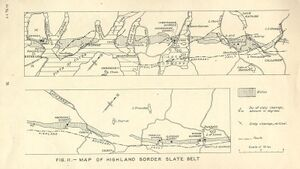Aberfoyle slate quarries, Highland Border slate belt, Scotland
| From: Richey, J.E. and Anderson, J.G.C. 1944. Scottish slates. Wartime pamphlet No. 40. London : Geological Survey of Great Britain. |
Aberfoyle


Maps
Sheet 38 Ben Lomond 1:50 000 geological map One inch to the mile (Geological, hand-coloured) Sheet 38
Six inches to the mile Perth 122, S.E.
| Locality | 1¾ ml. N.W. of Aberfoyle |
| Access | Half a mile by service road westwards from Aberfoyle – Loch Achray road. |
| Description of slate | Blue, grey, green and purple slates are produced, and also a mottled green and purple type termed ‘tartan slate’. The seams of different colours run parallel to cleavage. Pyrites practically absent. Surface even, slightly rough; texture fine to medium. Stripping due to bedding frequently present. Many thin quartz veins, generally coincident with cleavage. |
| Dips, with amounts | Cleavage-dip, N. at 60º-70º. Bedding-dip variable, due to small folds. |
| Joints | The slates are traversed by numerous joints, fairly widely spaces, following a variety of directions, none of which appears to be dominant. |
Details of workings
The positions of the various openings made in the slates are shown in (P519825) . The main workings are those to the north and are referred to as the Low Quarries. The following seams, arranged in order from north to south, are recognised in these workings.
| Seam (unnamed) | 10 ft. |
| Seam (unnamed) | 18 ft. |
| Silky Seam | 12 ft. |
| Seam (grey, green and blue slate) | 16 ft. |
| Home Seam | 20 ft. |
| Tartan Seam | 6 ft. |
| Grey Seam | 10 ft. |
Workable slate is also found interbanded with the poorer rock which occurs between these seams. A number of north-easterly faults occur, the more important of which are shown on (P519825) . The seas are shifted southwards on the west side of these faults.
The eastern portion of the Low Quarries consists of three large openings, the Smiddy Level, Home Quarry and Klondyke Quarry which are now not very clearly defined from one another. Their lower portions are heavily blocked with debris. Farther west and at a higher level, is the Lockout Quarry, an irregular opening about 100 yds. in diameter and 50 ft. deep. The Burnside Quarry still farther W. lies at about the same level and is of approximately the same dimensions.
S. of the Low Quarries, and at a considerably higher level, lies the so-called West Quarry, the face of which is about 200 yds. long and 50 ft. high. A seam about 30 ft. thick has been worked and is quite distinct from any of those in the Low Quarries.
Reserves
A Considerable amount of slate could still be quarried from the Lockout and Burnside Quarries, as well as from the upper part of the Home Quarry. It has been suggested that an adit should be driven southwards to cut the seam worked in the West Quarry at a lower level. The map (fig. 13) shows the manner in which expansion of the various openings has been hindered by faults. An important fracture marks the extreme western limit of all the present workings, but if large-scale development were to be contemplated in the future it should be possible to drive into the hillside W. of the fault to meet the same set of seams as those which occur in the Low Quarries, offset about 50 yds. to S. Continuation of the slate belt for a long distance to W. is assured.
To E. the ground falls away and is not so suitable for quarrying. Several trial holes have been made, but have not been developed far. There is an additional difficulty in the presence of a thick dolerite (whin) dyke which spoils the cleavage of the slate in its vicinity.